Magericyon: from fossil to virtual to art
One of the illustrations I did for the exhibition about Batallones fossil sites represents an adult female of the amphicyonid Magericyon agressively protecting its cubs. Such behaviour scenes, which imply portraying the animals in action, are quite complex to produce. Much of my “paleoartistic” work implies to establish the appearance of extinct animals that have never been depicted before, and the end result of such reconstructions is usually a picture of the animal in broadside view, standing or walking leisurely, so that the body proportions are seen most clearly.
This reconstruction of Magericyon is an example of such “canonic” ilustrations
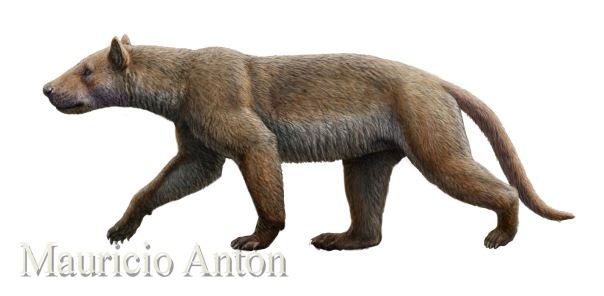
But when it comes to depict action, we need to see the animal as a 3-dimensional dynamic structure of bone, muscle and fur with the infinite possible combinations of posture, light and point of view. Virtual 3D technology can prove enormously helpful in all the stpes of this process.
In the previous months I had been collaborating with paleontologist Gema Siliceo in the creation of a virtual skeleton of Magericyon to be used in her Phd thesis dissertation about this carnivore, a task that involved many hours of work. First, each bone had to be scanned and the scans turned into virtual 3D objects, which then needed to be assembled in an anatomically correct virtual skeletal mount. This implied to create mirror copies of limb bones that were represented on one side only, and in a few cases to model missing bones by hand. Most importantly, the bones had to be articulated to each other in the correct angles, and for this task Gema’s painstaking study of the functional anatomy of Magericyon was vital. For example, she determined that the hind feet of this animal would have been essentially plantigrade, an important bit of information when we deal with a diverse family of extinct carnivores that included both plantigrade and digitigrade species.
Here we see a render of the virtual 3d skeleton of Magericyon, which served as a basis for the flesh reconstruction above

Returning to the action scene, I had created some preliminary pencil sketches showing the angry mother charging some invisible enemy. In those drawings I tried to approximate from memory how this amphicyonid would look if seen in mid-leap and in perspective

Then, I articulated the virtual skeleton in the desired pose and rendered it with different focal lenghts until I found an image that fit closely with the concept shown in my early sketches

Using the 3D render as a reference I could develop more detailed sketches and make sure that the drawings were faithful to the shape and proportions of the animal’s skeleton

From there on, the process was one of good-old digital painting, creating the right textures, illumination and mood

Nothing can take the place of pencil and paper, but there is no denying the contribution of digital technology to paleoart. With the time and resources it is possible and desirable to combine the best of both worlds
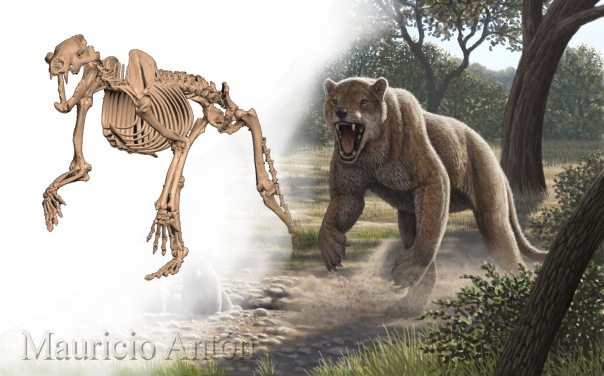
And there is more: we used this digital 3D model as a basis for a virtual animated reconstruction of the skeleton and the living animal, an exclusive feature that can be seen at the Batallones exhibit in Alcalá de Henares, Madrid. Well worth visiting!
Beyond the tiger’s stripes
Can we see through the tiger’s stripes? In order to draw it efficiently, it is a good idea to try. In the first stages of this quick pencil portrait of a female child of famous Bandhavgarh tigress “Spotty”, I purposefully ignored the stripes so I could render the general structure of the head. Once the three-dimensional shape is defined, adding the unmistakable facial markings is much easier.
Doomed predators: conveying the drama of carnivore entrapment in Batallones 3
Yet another of the illustrations I did for the great Batallones exhibition intended to depict an entrapment event at one of the carnivore traps, concretely Batallones 3. Some distinctive features of Batallones 3 are the large number of fossils of the larger sabertooth Machairodus aphanistus, which is the single most abundant species at the site; the presence of the bear Indarctos arctoides (absent in Batallones 1); and the abundance of giant tortoises of the species Titanochelon bolivari.
I planned a simple scene which showed these 3 main elements within the cavity, and I needed to gather all those big animals in a relatively small, closed space while still maintaining a sense of depth. One subtle aspect to consider was the angle of view. Put in other words, if I were a time-traveler and I could enter the cavity and take a picture of the scene, what lens should I choose?
In my first rough pencil sketch I chose an imaginary wide-angle lens, meaning that I got very close to the dead tortoise and sabertooth in the foreground and the bear in the background appeared to be farther away and thus looked smaller. This option created greater depth but it could make the cavity look too spacious

In a second pencil sketch I chose an imaginary 50mm lens or even a moderate telephoto. If I had been at the scene, this means I would have to step back from the smelly tortoise carcass and the anguished sabertooth (maybe hitting my head with the low roof of the cavity) in order to fit everything in the frame. The bear would look proportionally larger, and the cavity smaller
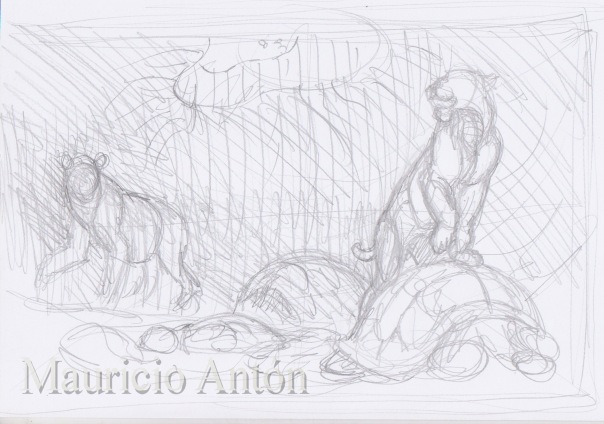
I choose the latter option and went ahead to block some of the shades with a sort of digital watercolour

When I tackled the final digital painting and the scene became more solid, once again I got the impression that the the viewer and animals were crowded in a too small room, so I corrected the view until I got something in between the first two options
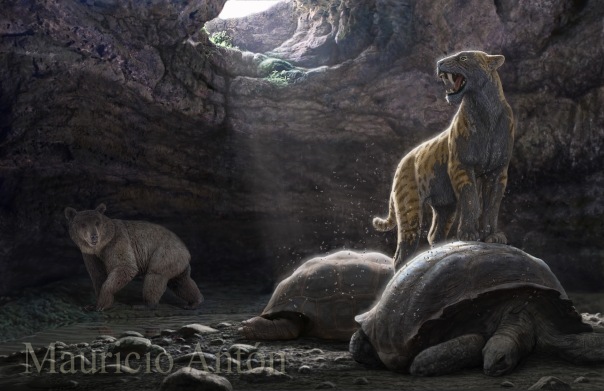
In order to give a little more depth to the scene I used some rays of light coming from the roof opening to suggest layers of atmosphere. Those effects, together with the somewhat “heroic” pose of the sabertooth give the scene and adventure feel, something like the cover of a comic book. But still the real scene would have been oppressing, so I devoted quite some time to dwell on the effect of the mud splatters on the cat’s fur or the flies buzzing around the rotting tortoise, all reminders of the down-to-earth drama that led to the eventual preservation of the fossils which we finally find in the site.
Sabertooth vs Bear-dog and Composition vs. Design
The last illustration I did for the Batallones exhibition correspons to a concept that had been on my mind for many months: a conflict between the two most fearsome predators from the site, the sabertooth Machairodus and the amphicyonid Magericyon. Only after the “warming up” of all the work in the rest of the pieces did I feel I was ready to tackle this one, and still it proved to be a challenge, not only for the composition itself but because of format limitations.
The image was intended to serve as cover art for the exhibition’s companion book, which meant a vertical format, but it would also serve other secondary purposes, so I had to extend the scene to the sides to allow it to function as a horizontal composition. Still, all the vital elements had to be grouped in the center so that the book cover would not look cropped up.
In my first pencil sketch I tried to fit the elements of the drama in the center. This is essentially NOT the way I use to compose. I like to place important elements on the sides of the frame so they will “pull” and create a tension that resolves somewhere in between (although never dead-center). I was beginning to solve the parts that would fit in the cover frame, but the whole composition felt lame.

In the second sketch I incorporated a third gomphothere approaching from the right. Depending on the amount of cropping, this animal might not even appear on the cover but I needed to expand a little from the center. I also incorporated some distant woods that put some welcome mass on the sides of the frame. Still, I felt the thing was lacking cohesion, with the elements in the center not having enough pull to keep the composition together.

In the third sketch I incorporated some trees that allowed me to organize the three-dimensional space of the scene. I also re-arranged the approaching gomphotheres so as to leave some breathing space in the vertical right above the dead beast. At this stage I decided to start with the digital painting.

In the early stages of the painting I felt like I was getting a grip on the composition but then we had a production meeting, and the design people showed me a preliminary placing for the titles. It was clear that the trees would provide too intense a background for some of the lettering.
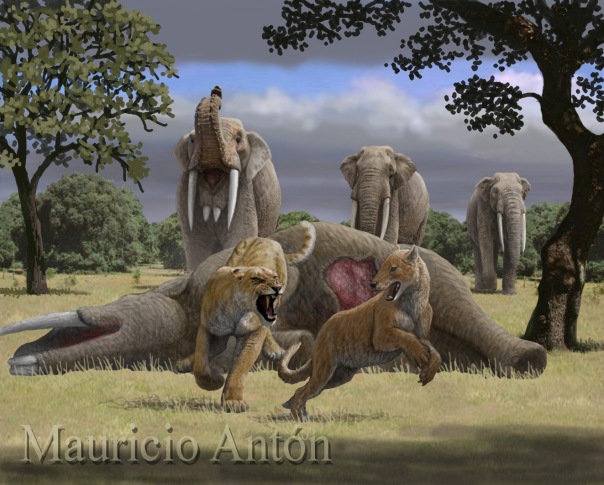
In the next stage of the painting I had already deleted the nearby trees. The only elements I could use to organice space (besides the animals themselves) were the distant vegetation, the clouds, and the patches of shadow. Also I had added some more painting on the top and bottom to leave room for more titles. But then I heard from the desgin people again: they would be using the piece for a big canvas banner hanging outside the museum building, and it needed to be very wide, so I had to add even more painting on the sides.

In the final version the animals look rather crowded in the center of the wide-angle landscape…

…but seeing the huge banner on the museum wall, choke-full of titles and institution logos, I admit there was no way around the need to zoom-out (although it took me quite a few hours of painting extra grass and bushes!)

The book cover, for which the whole thing was done to start with, still manages to encompass all the action within the frame.

For me, this is an example of an assignment that required sacrificing “pure” composition values in favor of a more “applied” approach. Demanding as these exercises can be, they are good for keeping us alert and humble as artists!
Machairodus pair: the intricacies behind a simple composition
One of the subjects I needed to depict for the Batallones exhibition was the sexual dimorphism in the Miocene sabertooth Machairodus aphanistus. In this species the males were considerably larger than the females, and the best way to reflect that fact was a simple illustration showing the relative sizes.
To illustrate the size dimorphism in Machairodus I just scaled up the same drawing to fit with the sizes of a very large (presumably male) and a very small (presumably female) adult individuals from Batallones 1 based on the measurements of their long bones (in this case the humerus)

But what would it be like to see a Machairodus couple in their environment? Would we see a striking difference as with modern lions or something more discreet as in leopards? In terms of its external appearance the lion is clearly the most dimorphic among living cat species, but surprisingly, in terms of body size the leopard is even more dimorphic. And yet, if you see an adult leopard out in the African bush, you may have a hard time trying to sex it unless the cat obligingly raises its tail. Some older female leopards can be so stocky and muscular that they would pass for a male, but then older male leopards often have very thick necks with a dewlap of loose skin hanging from their throats which make it easier to recognize them. Among tigers, the males not only are larger but they usually have a thick growth of long hair on the sides of their heads, a feature that is mirrored to some degree in other cat species.
What then about Machairodus? We have no evidence to infer a dramatic external feature like the lion male, not only because the lion is the outstanding exception among all living cats but because it is likely that the evolution of its mane has at least something to do with its similarly exceptional social structure. So for Machairodus I have inferred a similar coat for both sexes, although I have given a somewhat longer “beard” to the male. Also I have depicted the male yawning in order to show its large canines. After all, as in other cats, not only the male is larger than the female but it also has relatively larger canine teeth, and displaying them would be an important part of its body language.
For this illustration I decided to do a very simple composition with the two animals resting on the ground, and I quickly defined it with a rough pencil sketch

In a second pencil sketch I went into a little more detail, especially in the head of the male whose facial expression is more complex to portray
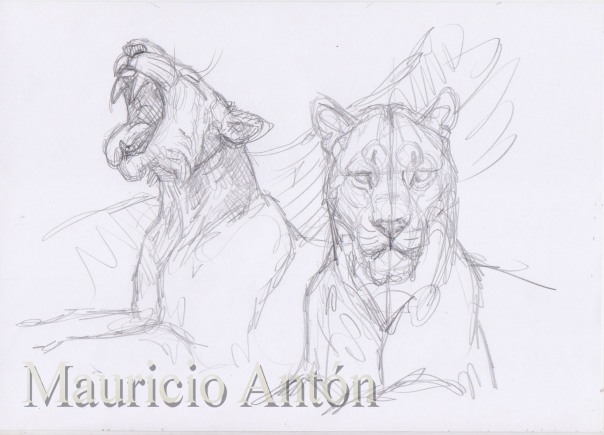
For the final version I used my computer 3D model of the skull of Machairodus, rendering it in the same views as the sketched heads so that I could check the proportions

Like other sabertooth cats, Machairodus had a somewhat longer and narrower skull than a modern cat of similar size. This difference would be partly masked in life by the thickness of soft tissue around the skull, but still it would be noticed, at least subtly.
In the final composition, the counterpoint to the shapes of the cats is provided by the fallen tree just behind the animals, but at one point I felt I needed one more, nearer plane in the picture. As an experiment I quickly added another fallen branch in the foreground, but I was not quite convinced by the effect

Finally I decided to delete the foregorund branch and leave the original, cleaner compostion

Was this the best option? Well, as in many other cases, I wouldn´t say for sure. I simply followed my instinct while trying to make choices within the limited time frame of this assignment. I had a large series of complex illustrations to do and a tight deadline, which, looking back, sometimes is a good thing. When you are a perfectionist of sorts, agonizing endlessly about your composition choices is a very real danger, so that limited time can be, ironically, the lesser of two evils!
Predators, Dreams, and Extinctions
I remember well the first excavations at the fossil site of Batallones-1, over a quarter of a century ago. After some teeth of the saber-tooth cat Promegantereon appeared at the site it seemed likely that, for the first time ever, a complete skull of the mysterious animal could be found. Back then, that possibility excited me so much that one night I even dreamed that we had discovered such a fossil and that I held the skull admiringly in my hands, as we drove to take it to the Madrid museum…
Reality fulfilled my dream and surpassed it by far. Today, we have so many complete skulls of Promegantereon from Batallones that they won’t fit on a large laboratory table. The sample of fossils from this site complex not only has provided complete skeletons of species that previously were known only from a few scraps, but it has yielded the remains of several species completely new to science. Dozens of academic papers and several Phd dissertations derived from the study of the sites have largely rewritten the history of the evolution of carnivorans and saber-tooth cats in particular.
These days there is a large exhibition celebrating the scientific success of the Batallones excavations. Some of the most amazing fossils that you can imagine are shown together in the hall of the Museo Arqueológico Regional de Madrid, in Alcalá de Henares. I have had the privilege to create a large series of illustrations updating the way we see the animals and environments of Madrid province some 9 million years ago.
This illustration I did for the Batallones exhibition depicts the best known carnivore species from the sites, shown at the same scale. They are shown life-size in the exhibition

In a way, this exhibition is another dream come true. My favorite beasts, the saber-tooth cats, have achieved center stage together with an amazing array of fossil carnivorans and other vertebrates. I am thrilled to think that many children will be exposed to the wonders of paleontology, as I was almost half a century ago when my imagination was set aflame by seeing a reconstruction of saber-tooth cats in their world painted by master paleo-artist Rudolph Zallinger.
But fossils are only half the story here. The fascination of saber-tooths derives from their combination of the strange and the familiar. Monstrous as they may appear to some, they were, after all, big cats. So, it is the modern big cats that have, so to speak, provided the flesh with which I have dressed the dry skeletons of their extinct relatives. As a child I dreamed of studying the fossils of saber-tooths but also of watching the big cats in the wild and learning about them first-hand. Those are dreams that I have fulfilled, and I am happy that I had the choice to pursue them. The fossils were there in the museums and in the sediments, and the living predators were there out in the wild. I could have settled to just learning about them through the pages of books (and later, computer screens), but I had the chance to go out and experience the real thing. But now I am worried about the options available to the children that will visit this exhibition.
I don’t know what are the chances that children now in school will be eventually able to pursue a career in paleontology (in Spain the prospect is already grim today), but their chances of seeing large carnivores in the wild a few years from now are deteriorating fast. To think that the last generation to enjoy the privileges we had regarding the observation of wildlife may be already alive is a sad but possible perspective. To experience an environment where big predators still rule is to renew our connection with the kind of world we are evolutionarily “designed” to live in, and to lose that connection is to enter an era of madness, a time of vicarious fulfillment of frustrated needs. And yet now we face a new variety of cynicism among some scientists, who claim that there is no point in lamenting extinctions because they have been happening for many millions of years and people eventually get used to everything, so after a while lost species will no longer be missed. A philosophy that contemplates without a tremor to deprive the next generations of the experiences that have enriched our own lives is the most depressing consequence of a world view that sees human life as little more than a balance between ingestion and excretion. Such views reveal the impoverished sensibilities of those scientists -or their will to downplay losses as a way to skip the fight to prevent them.
Now as you look to the assembly of magnificent carnivorans from the Miocene of Batallones, just imagine your grandchildren facing a similar illustration, but showing the lion, leopard, wolf, lynx, polar bear… by then completely extinct in the wild. Imagine the desolation of knowing that there is nowhere in the world where lions or tigers reign as sabertooths reigned in the distant past. Today those places still exist but if one day they disappear it will be, at least in part, because of our own idleness. Just by having a clear opinion and making it heard, or through our vote, we can make a difference. But trying to convince ourselves that extinction doesn´t matter is perhaps the ultimate sign of cowardice, and thinking that future generations will not be aware enough of their loss to reproach us is the farthest thing from a consolation. We need the fossils in the museums and the living predators out in the wild. Each thing in its place!
Machairodus hunting an Hipparion: from Raw Sketches to Final Art
One of the many illustrations I prepared for the new exhibition about the Batallones fossil site shows the large sabertooth cat Machairodus aphanistus hunting a three-toed horse of the genus Hipparion.
I needed to illustrate the key moment of the killing bite, and as a result the predator and prey duo make a dramatic but not especially dynamic ensemble, with the horse being pinned to the ground by the weight of the predator. I had previously rendered this action as a pencil drawing on a white background, but this time I wanted to place the animals in their habitat, showing the kind of environment that allowed the sabertooth to creep on its prey taking advantage of cover. But how to create a dynamic environmental composition when the center of attention is at the same time violent and static? Placing the kill in the center of the frame would neutralize the composition, creating a sort of implosion where everything else becomes superfluous.
My first decision was thus to move the cat and horse, and especially their heads which would attract all attention, away from the frame’s center. This decision at the same time made the composition more dynamic and threw it out of balance so I included a second cat in the scene to put something on the empty left side. In my hypothetical story, the hunting cat would be an adult female, while this second individual would be a grown cub, of the kind that sometimes assist and sometimes ruin their mother’s kills. Such a scenario is derived from the behavior of modern big cats and it allowed me to make the presence of a second large cat compatible with the likely solitary life of these sabertooths.
In this first raw sketch I quickly outlined the masses of the three animals, and used several trees to organize the rest of the space in the frame. Looking at the draft I felt that the second cat had perhaps too much importance in this composition, how to solve this problem?

In this second pencil drawing I attempted to leave the second cat in shadow in order to center the attention on the kill, but even with such a quick sketch I noticed that there was enough intensity on the predation without further highlighting it. The second cat should retain its share of the sunlight

In this third sketch I calculated the effects of perspective more carefully and found that I could place the second cat at a distance where it would look conveniently smaller than the hunting cat. With the animals approximately placed in the composition I began to work in the digital painting

As the painting began to take shape I found that the trees were shaping the composition a bit too strongly. Drawn with a few light pencil strokes, they seemed to arrange the space conveniently, but when those lines became solid branches they almost appeared to be enveloping the animals, like the sinister “Old Man Willow” capturing the hobbits in The Lord of the Rings… So I trimmed the lower branches leaving some breathing space for the animals and creating a corridor for our eyes to look into the mid-distance. Other changes included to block the view of the distant hilltop (which resonated too much with the shapes of the animals and seemed also to compete for attention) and to replace the tree trunk in the left side foreground with a more modest shrub.
In the finished painting I added a marten-like mustelid climbing on the tree trunk on the right, an element that further dilutes the tension. All in all I tried to compensate the violence of the kill with an apparently matter-of fact distribution of the elements in the composition so it would not look overly dramatic
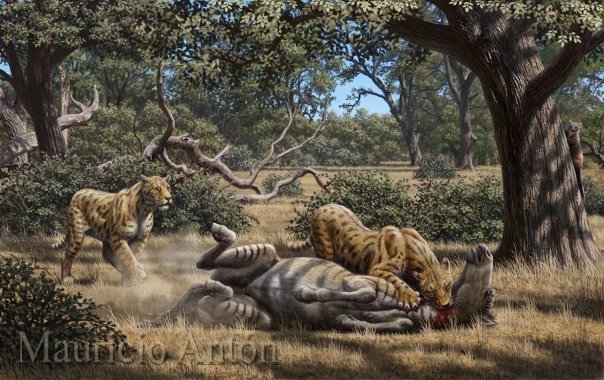
The random patterns of light and shadow on the ground also intend to treat the story’s “stars” almost as just two more objects placed in the landscape, like something you could see while driving along in your safari vehicle. I don’t claim that this anti-dramatic treatment is the best solution for this painting, but it is what my instincts dictated as I went along. Following your instincts is in no way an infallible recipe for success, but as an artist it is still the best compass you have for finding your way through the conflicts of a complex work!
Ellesmere’s Early Bear Revealed
A couple of years ago I was approached by my friend Xiaoming Wang and his team of paleontologists with an exciting proposal: to create a reconstruction of a new bear species they were describing from the High Arctic Ellesmere Island. Ellesmere has a magical resonance for me as the legendary place where the biology of wolves was revealed as never before thanks to direct observations of wild packs that were undisturbed by human encroachment. But of course it is also a place of amazing fossil sites, including one called Beaver Pond Site which provides a wonderful window into the high Arctic ecosystems during the Pliocene.
The first step for my reconstruction was to draw the ancient bear’s skeleton using photographs and measurements of the fossils. Many bones were missing from the site and had to be drawn on the basis of those of living relatives, but still there was enough material to create a reliable approximation fo the animal’s body proportions. The resulting skeletal drawing shows an animal of moderate size, not very different in build and mass from an extant black bear.
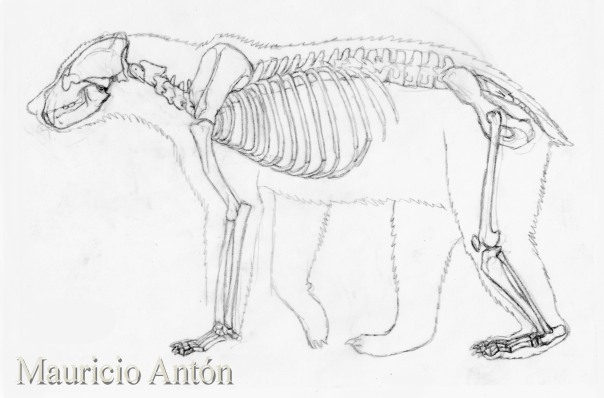
A vital part of the reconstruction was to create an accurate rendition of the animal´s face, and for that we had the benefit of a remarkably well preserved partial cranium and mandible. In fact the team sent me a 3D scan of the skull which allowed me to visualize the fossil from any point of view, choosing the best angle to show the bear’s “personality” to advantage.
In this 4-step sketch you can see the process leading from the original render of the digital 3D scan of the skull, followed by the definition of the main muscle masses and the addition of cartilage, skin and fur to complete the outline of the living animal’s head.

The final stage of the reconstruction was to place the animal in a natural setting. The High Arctic Pliocene environment was reconstructed with the help of copious paleobotanical data provided by members of the team. In the background you can see a beaver hard at work in the maintenance of the pond that gives the fossil site its name, and which was an important factor in the local environment.

Nowadays there are no beaver ponds in Ellesmere but its hardy wildlife, including its amazing white wolves, is key for understanding and restoring wild ecosystems through the Holarctic, a kind of reconstruction that is very different from paleoart, and one that we should master if our species is to survive in the long term.
Check the original scientific publication here:
https://www.nature.com/articles/s41598-017-17657-8
TO BITE AND NOT BE BITTEN: THE CHALLENGE OF THE CAIMAN-EATING JAGUARS
Mysteries still remain around the killing bite of the sabertooths, although it seems clear that they relied on a combination of a huge gape and a surgically precise cut through the softer parts of their prey (such as the throat) to achieve a rapid death through blood loss. Modern big cats on the other hand use a different technique, applying strong and prolonged pressure with their short and robust canines, either suffocating their prey or crushing vital parts.
Among the pantherine cats, it is difficult to imagine a killing bite more different from that of sabertooths than the one employed by jaguars in South America to hunt caimans. What sort of anatomical adaptations allow the jaguar to deliver a bite devastating enough to kill a creature that boasts one of the most formidable armours in nature? In a recent assignment from National Geographic Magazine we set to explore precisely that subject, and how to reflect it in images.
Research into the anatomy of the skull of pantherines by several specialists has shown that the skull of the jaguar is adapted for generating larger bite forces than other big cats, due to slightly increased jaw leverage and to the larger cross-sectional area of the masticatory mucles, especially the temporal and masseter. But the differences with other species of the genus Panthera are subtle and there is also a behavioural factor, a preference (either genetically programmed or learned, or both) by the jaguars to go for a skull bite where other big cats would aim at the prey’s neck. When the chosen prey is a large caiman, as often is the case among jaguars from Brazil’s Pantanal, the efficiency of the skull bite is simply astounding. As the jaguar usually surprises the caiman from above and behind, the skull or nape bite is simply the best way to bite and not be bitten by a prey that can revolve and snap its deadly jaws with lightning speed.
Jaguars in the Pantanal spend lots of time patrolling the water margins in search of such prey as capibara or caimans. Photo courtesy of Luke Hunter/Panthera

Caimans are an important part of the Pantanal jaguars’ diet, wether they actively hunt them or scavenge them as in the case of this picture. Photo courtesy of Rafael Hoogesteijn/Panthera

For the National Geographic illustration, art editor Mónica Serrano proposed to work in layers so that we would have freedom to decide what parts of the anatomy of both predator and prey to show.
After all, the killing bite is an interaction between the geometries of both animals and the jaguar needs to allign its head and jaws in a very concrete position in order to penetrate the caiman´s superb armour. This interaction is so compex that there is no hope to show all the relevant factors in one single, 2-dimensional image.
My first pencil sketch, based in a draft sent early on by Mónica, shows the jaguar´s head in near-frontal view, which is the only way for us to show the relevant features of the caiman’s head and neck in a recognisable way

By choosing a frontal view we lost the opportunity to show clearly one important aspect of the jaguar’s killing bite: gape!
Although the gape of modern cats is small compared to that of the sabertooths, they are still capable of opening their jaws to an impressive degree as shown in this picture. Such gapes are neccesary if the jaguar has to encompass the head of a large caiman between the tips of its canines. Photo courtesy of Luke Hunter/Panthera

Once we established the angle of view, I proceeded to draw the anatomy of both animals from the inside out. This is an excercise I am pretty familiar with from my reconstruction work, but in this case I have the advantage of working from images of dissections and CT scans of the real animals, rather than having to infer the development of muscles from their attachment areas in the bone only.
I started by drawing the skulls of caiman and jaguar in a position corresponding to the killing bite

In the next layer I put the muscles in place. In jaguars, the great width of the area encompassed by the zygomatic arches, known as the temporal fossa, is a clear sign of the huge development of its temporalis muscle

In the final layer, I show the external appearance of the animals, with the armour of the caiman much in evidence
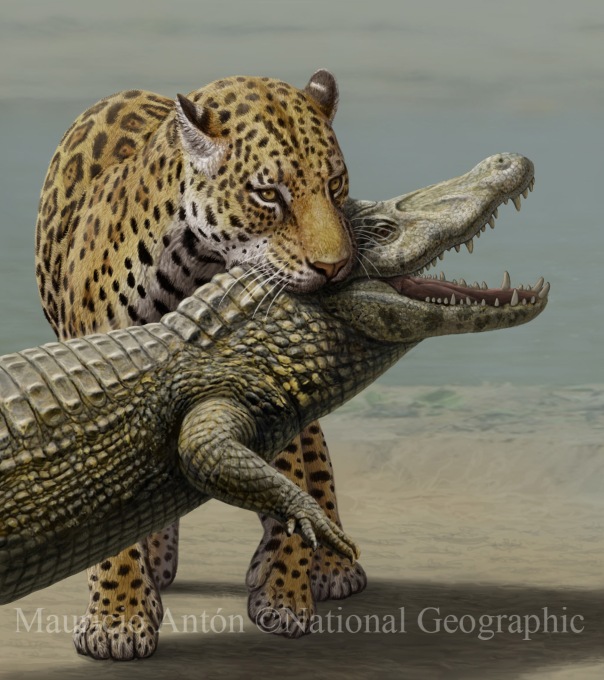
At this point in the process there was still an important task ahead: to select what sections of the deeper layers to show through. That was up to Mónica and her team, who produced the published image as we see it here

Using transparency and additional outlining it was possible to show the position of the jaguar’s mastication muscles, the caiman´s neck vertebrae and even its tiny brain.
In this video you can see the whole sequence of images, from the early pencil sketches to the layers of the colour illustration, and you can appreciate the difficult choices about what to show and what to hide.
See the National Geographic article on jaguars as published in the December issue of the magazine in this link:
https://www.nationalgeographic.com/magazine/2017/12/shrinking-kingdom-of-the-jaguar/
All artwork by Mauricio Antón, ©National Geographic
The Great Ibex Showdown
The complex shape of the ibex horns has evolved over millions of years for a very particular fighting style. You can study the morphology of the horn sheaths, horn cores and skull and see how the whole structure is reinforced to withstand the brutal blows, but to fully understand the relationship between form and function you need to see the real animals fighting each other. In one modality of their ritualized choreography, one of the contenders raises on his hind legs and gets ready to fall on the defender, who in turn adjusts his position to receive the attacker. As the impact becomes imminent, each animal orients its head quite precisely so that the forces will be properly channeled. In other occasions, both contenders raise and the trajectories towards impact are more symmetrical.
With extinct animals we can only infer their fighting styles from the morphology of their skulls and head appendages, but with living animals there is no end to how much we can learn by observing directly their real behavior. Such observations help us anchor more solidly our hypothesis about the habits of completely extinct beasts.
In this photo taken by my son Miguel, you can see two standing contenders about to start their descent, their laterally placed eyes fixed intently on each other as they prepare for the impact

In this other picture you can see the classic fight modality where one contender is distinctly above the other
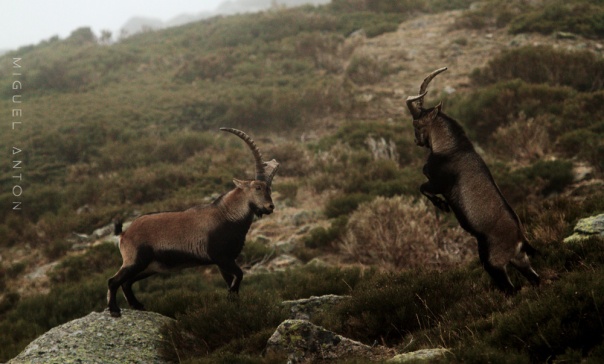
This image shows the moment of impact, when even the hind legs stretch to liberate the immense energy of the blow

To see the whole process in action, check the second part of my Spanish ibex video here:


